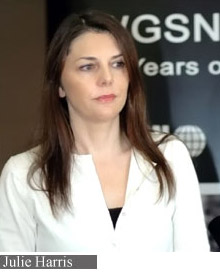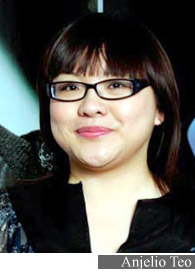 Yet another instance of bringing you an insight of the Fashion world as Asha Kumari catches Julie Harris, Managing director, Asia Pacific, WGSN and Anjelio Teo, Head of Content, Asia Pacific, WGSN, exclusively for Fashionfad.in.
Yet another instance of bringing you an insight of the Fashion world as Asha Kumari catches Julie Harris, Managing director, Asia Pacific, WGSN and Anjelio Teo, Head of Content, Asia Pacific, WGSN, exclusively for Fashionfad.in.
The story begins with the squeaking stilettos of Julie as she gathers remarkable attention during her presentation at the WIFW SS’10. Julie can be easily mistaken to be a fashion icon herself coming from the clan that is the foresight of fashion. And Anjelio based in Hong Kong, oversees an expert team and a network of freelancers across the Asia Pacific region. Anjelio in her account of India therapy writes for WGSN, “A cacophonous mix of colour and sound, all so foreign, jarring and beautiful at the same time. There are sights here you’ll never see elsewhere and sounds and smells that will linger on in your memory for years after. India seeps into your skin.” Now let’s get the experts talking-
What are the various parameters that influence the fashion forecast of any season?
Fashion is influenced by nearly everything and anything under the sun. Beginning from the climatic conditions it digs out references from culture, music, politics, economy and all the little ingredients that are making a difference or have the potential to do so. Trends from the street scrutinized under the eyes of the experts, great things in design (furniture, space, lamps etc. utility driven or luxury driven), design innovations and of course art, it is the luxury answering commercial. Each day we analyse events around the world to create a strong understanding of consumer behavior, and an inspirational well informed future.
We work 18 months in advance of the season to develop the forecast. Each forecast is followed on the catwalks of Milan to the streets of Tokyo. Confirmation is taken at every stage and necessary amendments taken care of and conclusions drawn.
Brief about your client base
 WGSN is the global trend analysis resource for all design related industries. We provide creative intelligence across 60 countries to over 35,000 users from designers to fashion brands, retailers and manufacturers. Among our international associates are Louis Vuitton, Giorgio Armani, Zara, Walmart, Nike and Adidas to name a few. In India we have been forecasting for companies like Shoppers Stop, Madura, Raymond, Titan and Numero Uno.
WGSN is the global trend analysis resource for all design related industries. We provide creative intelligence across 60 countries to over 35,000 users from designers to fashion brands, retailers and manufacturers. Among our international associates are Louis Vuitton, Giorgio Armani, Zara, Walmart, Nike and Adidas to name a few. In India we have been forecasting for companies like Shoppers Stop, Madura, Raymond, Titan and Numero Uno.
Fashion capitals have been shifting their base since its origin. Like in the 60’s London ruled the world of fashion before Paris established itself as the undisputed monarch in 80’s and 90s.
Because fashion is not revolutionary it is evolutionary. When you see someone dressed up differently people start talking about it and the acceptance is not that easy. Fashion works on a trickle-down theory or a trickle-up theory. In the former case style icons and trend setters introduce a new fashion statement and from there it flows down to the people who are constantly refurbished in vogue and very gradually the trend transcends to masses. The trickle-up theory supports a street trend which picks up very fast and soon shows up in vogue among the top niche of fashion. And as fashion always follows a cycle it takes its due course. For example this season the colour beige is in vogue. In this age of globalisation of trends beige is easier on the eye and you just have to find the exact shade of beige to match the skin type of every region.
How do you perceive the Indian fashion market?
Fashion in India has the local ethnic flavor with contemporary finishing which has a great market internationally. India brings to the global forum something that it has not seen before. Indian designers have an individualistic appeal with their excellent use of colours. We also find that there is awareness about the eco friendly clothing and human rights issues in India. Thus there is a strong need for the designers here to launch themselves globally. One of the buyers said that a lot of International designers have started looking the same however Indian designers have still retained their distinct sensibility. This is the first time that we are at WIFW, though we have been at the LFW as well. But we did not see the contemporization strongly enough at Lakme as is visible here. The WIFW is more organised it is easy for the buyers as they are getting appointments with the designers easily and the designers are competent enough for the business. Buyers are buying more than they intended to. I would like to add that the soul purpose of both the fashion weeks in India is to promote the Indian fashion industry. So they should not have two faces for the international market. There should be one single united face of Indian fashion.
How would WGSN help the Indian designers?
This is the first time we are trying to reach out to designers in India. Our services our quite expensive for individual designers to purchase, so we with Sunil Sethi, President, Fashion Design Council of India are working out a feasible module to provide designers under the umbrella of FDCI a subsidized fees. We are still working out the finer details but at present the proposition is such that we would stipulate the FDCI an annual license for five users at 15,000 pounds (approx)








